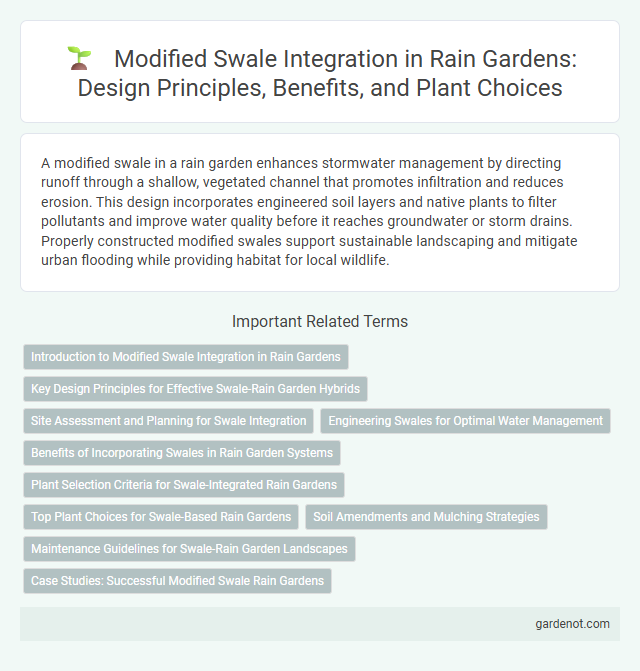A modified swale in a rain garden enhances stormwater management by directing runoff through a shallow, vegetated channel that promotes infiltration and reduces erosion. This design incorporates engineered soil layers and native plants to filter pollutants and improve water quality before it reaches groundwater or storm drains. Properly constructed modified swales support sustainable landscaping and mitigate urban flooding while providing habitat for local wildlife.
Introduction to Modified Swale Integration in Rain Gardens
Modified swales enhance rain garden efficiency by directing stormwater runoff into vegetated channels designed for filtration and infiltration. These engineered landscapes control water flow, reduce erosion, and improve water quality by promoting sediment deposition and pollutant uptake. Integrating modified swales in rain gardens optimizes hydrological performance while supporting native plant growth and biodiversity.
Key Design Principles for Effective Swale-Rain Garden Hybrids
Modified swales in rain garden design optimize stormwater management by integrating vegetative filtration with graded channels that promote infiltration and slow runoff. Key design principles include ensuring proper slope between 1-5% to maintain flow without erosion, selecting deep-rooted native plants for enhanced pollutant uptake, and incorporating engineered soils with high permeability to increase water absorption capacity. Effective swale-rain garden hybrids prioritize overflow controls, sediment traps, and regular maintenance to sustain long-term hydrological performance and ecological benefits.
Site Assessment and Planning for Swale Integration
Site assessment for modified swale integration in rain gardens involves evaluating soil permeability, slope gradient, and existing drainage patterns to ensure optimal water infiltration and flow control. Planning requires mapping the watershed area, identifying runoff sources, and calculating volume and flow rate to size the swale appropriately. Incorporating native vegetation in the design enhances pollutant removal and stabilizes soil, promoting long-term sustainability.
Engineering Swales for Optimal Water Management
Modified swales are engineered channels designed to capture, convey, and infiltrate stormwater efficiently within rain gardens. Incorporating features like graded slopes, vegetation buffers, and subsurface layers, these swales optimize water retention and reduce runoff velocity, enhancing groundwater recharge and minimizing erosion. Strategic placement and tailored design of modified swales improve flood control and support sustainable urban water management.
Benefits of Incorporating Swales in Rain Garden Systems
Incorporating modified swales in rain garden systems enhances stormwater management by efficiently directing runoff and promoting groundwater recharge. These swales reduce erosion and filter pollutants through vegetation and soil, improving water quality in urban landscapes. Their integration supports biodiversity and mitigates flooding by slowing and absorbing excess rainwater.
Plant Selection Criteria for Swale-Integrated Rain Gardens
Plant selection for swale-integrated rain gardens emphasizes native species with deep root systems to enhance infiltration and stabilize soil. Species must tolerate periodic flooding and drought, balancing water absorption and resilience in fluctuating moisture conditions. Incorporating diverse grasses, sedges, and perennials supports ecological function, improves pollutant filtration, and promotes habitat biodiversity within the modified swale environment.
Top Plant Choices for Swale-Based Rain Gardens
Top plant choices for swale-based rain gardens include native species such as Carex stricta (Tussock Sedge), Juncus effusus (Soft Rush), and Asclepias incarnata (Swamp Milkweed) due to their high tolerance for varying moisture levels and ability to improve water filtration. These plants enhance soil stabilization and support local ecosystems by attracting pollinators like bees and butterflies. Selecting diverse herbaceous perennials and grasses ensures effective stormwater management and sustainable swale function.
Soil Amendments and Mulching Strategies
Modified swales in rain gardens enhance stormwater management by incorporating tailored soil amendments such as compost and biochar to improve infiltration rates and nutrient retention. Strategic mulching with organic materials like wood chips or straw safeguards soil moisture, reduces erosion, and promotes microbial activity essential for healthy plant growth. These combined soil and mulching techniques optimize pollutant filtration and bolster the overall sustainability of rain garden ecosystems.
Maintenance Guidelines for Swale-Rain Garden Landscapes
Maintaining swale-rain garden landscapes requires regular inspection to ensure proper water flow and prevent sediment buildup that can obstruct drainage. Vegetation should be pruned to promote healthy growth while minimizing blockages, and invasive species must be controlled to preserve native plant diversity. Periodic removal of accumulated debris and sediment enhances infiltration efficiency, sustaining the swale's effectiveness in managing stormwater runoff.
Case Studies: Successful Modified Swale Rain Gardens
Modified swale rain gardens have demonstrated remarkable effectiveness in urban stormwater management, as evidenced by case studies such as Seattle's Thornton Creek restoration project, which reduced runoff volume by 70% while improving water quality through sediment capture and pollutant filtration. In Portland, Oregon, the Tryon Creek watershed project showcased how integrating native vegetation within modified swales enhanced infiltration rates and provided critical habitat for pollinators. These examples highlight the adaptability of modified swale rain gardens in diverse climates and urban settings, promoting sustainable water management and ecological benefits.
Modified swale Infographic

 gardenot.com
gardenot.com